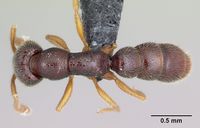Stigmatomma bolabola
| Stigmatomma bolabola | |
|---|---|

| |
| Scientific classification | |
| Kingdom: | Animalia |
| Phylum: | Arthropoda |
| Class: | Insecta |
| Order: | Hymenoptera |
| Family: | Formicidae |
| Subfamily: | Amblyoponinae |
| Tribe: | Amblyoponini |
| Genus: | Stigmatomma |
| Species group: | tsyhady |
| Species complex: | sakalava |
| Species: | S. bolabola |
| Binomial name | |
| Stigmatomma bolabola Esteves & Fisher, 2016 | |
Stigmatomma bolabola was collected in two localities of the Makira Forest Protected Area, in rainforest and montane rainforest habitats in the humid forests ecoregion of Madagascar (at 600 m and 1100 m respectively; following the classification of Burgess et al. 2004). Specimens were recorded from sifted leaf mold and rotten wood. (Esteves and Fisher 2016)
Identification
Esteves and Fisher (2016) - A member of the sakalava complex in the tsyhady species group. Stigmatomma bolabola may be confounded with Stigmatomma sakalava by the following characters: absence of genal teeth, palpal formula, single mesotibial spur, head sculpture, shape of subpetiolar process, and presence of stout spiniform setae on the apex of hypopygium. However, it is easily recognized by the sculpture of its mesosoma lateral face and propodeal declivitous face, katepisternum shape, proportion of lamella on the basoventral margin of calcar of strigil, and distribution (since they do not occur in sympatry).
With characters of the tsyhady species-group and the sakalava species-complex, and the following characters (asterisks flag unique characters within the genus in the Malagasy bioregion):
1. Integument red-brown; medium-sized ant (HL: 0.76, WL: 0.92).
2. Dorsal teeth row of mandible’s pairs of teeth increasing in size towards mandibular apex.
3. Row of acuminate flattened-apex setae setae ventrally skirting mandible’s basomasticatory margin, parallel to row of flexuous, longer setae.
4. Dorsal face of the head mostly foveate-reticulate/densely foveate.
5. Genal teeth absent.
6. Palpal formula 4:2.
7. Dorsal face of mesosoma foveate; lateral face of pronotum rugulose-foveate; lateral face of propodeum costate-foveolate.
8. * Declivitous face of propodeum strigate.
9. * Mesepisternum divided into anepisternum and katepisternum; posterodorsal corner of katepisternum rounded.
10. * Basoventral one-fifth of calcar of strigil lamellar.
11. Calcar of strigil anterior face with tubiform microtrichia.
12. Single mesotibial spur covered with lanceolate microtrichia.
13. Longitudinal slit-like sulcus present on the anterodorsal face of mesobasitarsus.
14. Anterior face of posterior metatibial spur glabrous; posterior face with antler-like microtrichia.
15. Brush of long truncated-apex filiform setae present on the posterior face of metatibial apex.
16. Brush of tubiform setae present on the baso-inner face of metabasitarsus.
17. Absence of sulcus on metabasitarsus.
18. Subpetiolar process fin-like: half of its ventral margin obtusely angled.
19. Eight stout spiniform setae present on the apex of hypopygium.
Keys including this Species
Distribution
Latitudinal Distribution Pattern
Latitudinal Range: -15.17833° to -15.28833°.
| North Temperate |
North Subtropical |
Tropical | South Subtropical |
South Temperate |
- Source: AntMaps
Distribution based on Regional Taxon Lists
Malagasy Region: Madagascar (type locality).
Distribution based on AntMaps
Distribution based on AntWeb specimens
Check data from AntWeb
Countries Occupied
| Number of countries occupied by this species based on AntWiki Regional Taxon Lists. In general, fewer countries occupied indicates a narrower range, while more countries indicates a more widespread species. |

|
Estimated Abundance
| Relative abundance based on number of AntMaps records per species (this species within the purple bar). Fewer records (to the left) indicates a less abundant/encountered species while more records (to the right) indicates more abundant/encountered species. |

|
Biology
Castes
Only known from the worker caste.
Worker
Images from AntWeb
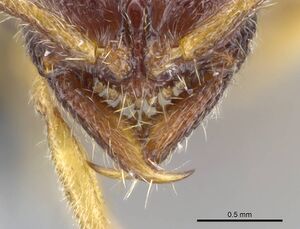 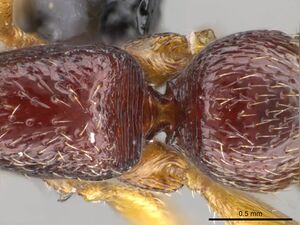    
| |
| Holotype of Stigmatomma bolabola. Worker. Specimen code casent0034580. Photographer April Nobile, uploaded by California Academy of Sciences. | Owned by CAS, San Francisco, CA, USA. |
   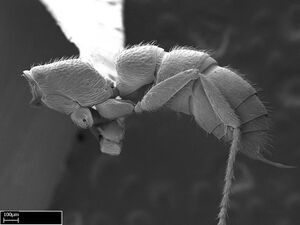        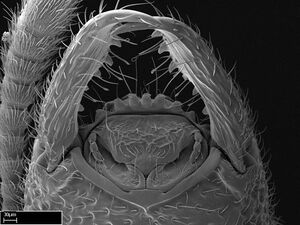 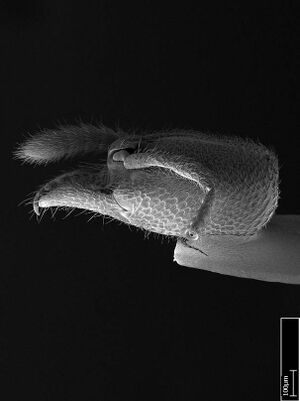   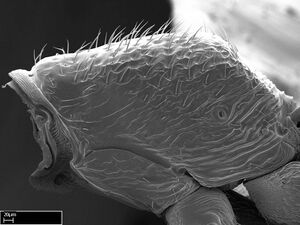  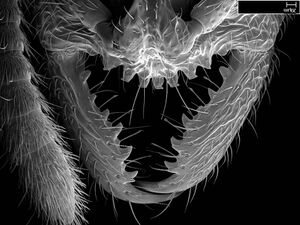 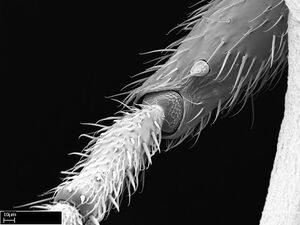 
| |
| Worker. Specimen code casent0034744. Photographer Flavia Esteves, uploaded by California Academy of Sciences. | Owned by CAS, San Francisco, CA, USA. |
Nomenclature
The following information is derived from Barry Bolton's Online Catalogue of the Ants of the World.
- bolabola. Stigmatomma bolabola Esteves & Fisher, 2016: 45, figs. 28-33 (w.) MADAGASCAR.
- Type-material: holotype worker.
- Type-locality: Madagascar: Montagne d’Akirindro, 7.6 km. 341° NNW Ambinanitelo, -15.28833, 49.54833, 17.iii.2003, BLF08250, CASENT0034580, sifted litter (leaf mold, rotten wood) (Fisher, Griswold, et al.)
- Type-depository: CASC.
- Distribution: Madagascar.
Unless otherwise noted the text for the remainder of this section is reported from the publication that includes the original description.
Description
Worker
holotype: HL: 0.76; HW: 0.59; HW2: 0.49; SL: 0.45; ML: 0.41; WL: 0.92; PPW: 0.34; PtL: 0.29; PtW: 0.41; CI: 78; SI: 60; MI: 54; PtI: 72.
Head: Mandibular baso-masticatory margin skirted dorsally by row of filiform setae; ventrally, by acuminate flattened-apex setae, and row of longer filiform setae. Mandibular dentition arrangement, from base to apex: row of three single teeth (same dimensions of teeth arranged in pairs); three pairs of teeth (each teeth pair fused basally); single preapical tooth; apical tooth. Dorsal teeth pairs increasing in length towards mandibular apex. Anterior clypeal margin with nine tubercle-like cuticular processes arranged in a single row. All clypeal cuticular processes, except the most lateral, armed anteriorly with truncated dentiform seta; most lateral processes smaller and unarmed. Median clypeal cuticular processes around 3x the length of associated dentiform setae. Pair of long filiform setae on clypeal median area, posterior to tubercle-like cuticular processes on clypeal anterior margin. Pair of shorter filiform setae on clypeal median area posterior to longer setae pair, followed posteriorly by longitudinal row of much shorter filiform setae. Clypeal median area extending posteriorly between antennal sockets as narrow longitudinal strip; frontoclypeal sulcus acute. Supraclypeal area as oval shaped concavity. Twelve antennomeres.
Genal teeth absent. Widest diameter of compound eyes: 2-3 ommatidia. Palpal formula: 4:2 (four maxillary, two labial).
Mesosoma: In dorsal view, mesonotum narrower than remaining mesosoma. Metanotal suture absent. Sulcus divinding mesepisternum into anepisternum and katepisternum; posterodorsal corner of katepisternum rounded. Metathoracic spiracle slit-like, reduced in size. Propodeal spiracle round, surrounded by cuticular swell, followed by sulcus. Propodeal declivitous face not concave.
Legs: Basoventral fifth of calcar of strigil lamellar. Calcar of strigil anterior face with tubiform microtrichia; posterior face with lanceolate microtrichia. Multiple paddle-like setae on anteroventral face of protibial apex, next to calcar of strigil. Multiple paddle-like setae on anterior face of probasitarsus; stout setae on apex of posterior face. Single mesotibial spur with lanceolate microtrichia. Slit-like longitudinal sulcus on anterodorsal face of mesobasitarsus. Row of stout setae along inner face of mesobasitarsus. Two metatibial spurs; simple anterior spur with lanceolate microtrichia; posterior spur pectinate. Anterior face of posterior metatibial spur glabrous; posterior face with antler-like microtrichia. Brush of long, truncated filiform setae on posterior face of metatibial apex, next to posterior metatibial spur. Absence of longitudinal sulcus on anterodorsal face of metabasitarsus. Brush of tubiform setae on baso-inner face of metabasitarsus. Stout setae on remaining inner face of metabasitarsus. Arolium on pro-, meso-, and metapretarsus.
Metasoma: Petiole sessile. Ventroanterior margin of petiolar tergite anterior dorso-lateroventral carina (Ward 1990) much shorter than anterior margin of subpetiolar process, in lateral view. Subpetiolar process with obtuse angle at mid-point of its ventral margin (fin-like). Absence of fenestra on lateral face of subpetiolar process. Petiolar proprioceptor zone a large, round concavity with few sensilla. Prora present. Scrobiculate sulcus between pretergite and postergite of abdominal segment III and presclerites and postsclerites of abdominal segment IV. Eight stout spiniform setae on apex of hypopygium.
Sculpture: Mandibular dorsal face rugose-foveate basally, grading into costate-foveolate apically except for smooth apical portion. Clypeal median area costate. Supraclypeal area smooth. Head, in dorsal view, mostly foveate-reticulate/densely foveate; area posterior to tentorial pit plicate. Labrum rugose. Mesosoma foveate dorsally. Pronotum rugulose-foveate laterally. Anepisternum scarcely costulate; katepisternum costate-rugulose. Metapleuron mostly costate. Lateral face of propodeum costate-foveolate; declivitous face strigate. Petiolar tergite, in lateral view, areolate/imbricate ventroanteriorly, grading into strigate dorsoanteriorly, costate laterally, foveate dorsally. Petiolar laterotergite imbricate posteriorly. Petiolar poststernite mostly alveolate, grading into smooth ventrally. Abdominal segment III foveolate; remaining gaster puncticulate.
Pilosity and color: Suberect pilosity on head, dorsal face of mesosoma, lateral face of propodeum, petiolar tergite, and abdominal segments III and IV. Petiolar poststernite mostly glabrous. Longer pilosity on abdominal segments V, VI and VII. Body color red-brown; apex of gaster and appendages orange-yellow.
Type Material
Holotype: Madagascar; Montagne d'Akirindro 7.6 km 341° NNW Ambinanitelo; -15.28833; 49.54833; 03/17/2003; rainforest; BLF08250; sifted litter (leaf mold, rotten wood); 1w; casent0034580; Fisher, Griswold et al.; California Academy of Sciences
Etymology
Bola- bola is the name that Malagasy people give to logs of rosewood, a plant of the genus Dalbergia (Schuurman 2009). Stigmatomma bolabola is named for the resemblance between its color and that of rosewood timber, and because it lives in the region of Madagascar most affected by illegal rosewood logging.
Determination Clarifications
Stigmatomma MG03 (specimen CASENT0034580) in Ward and Fisher (2016).

